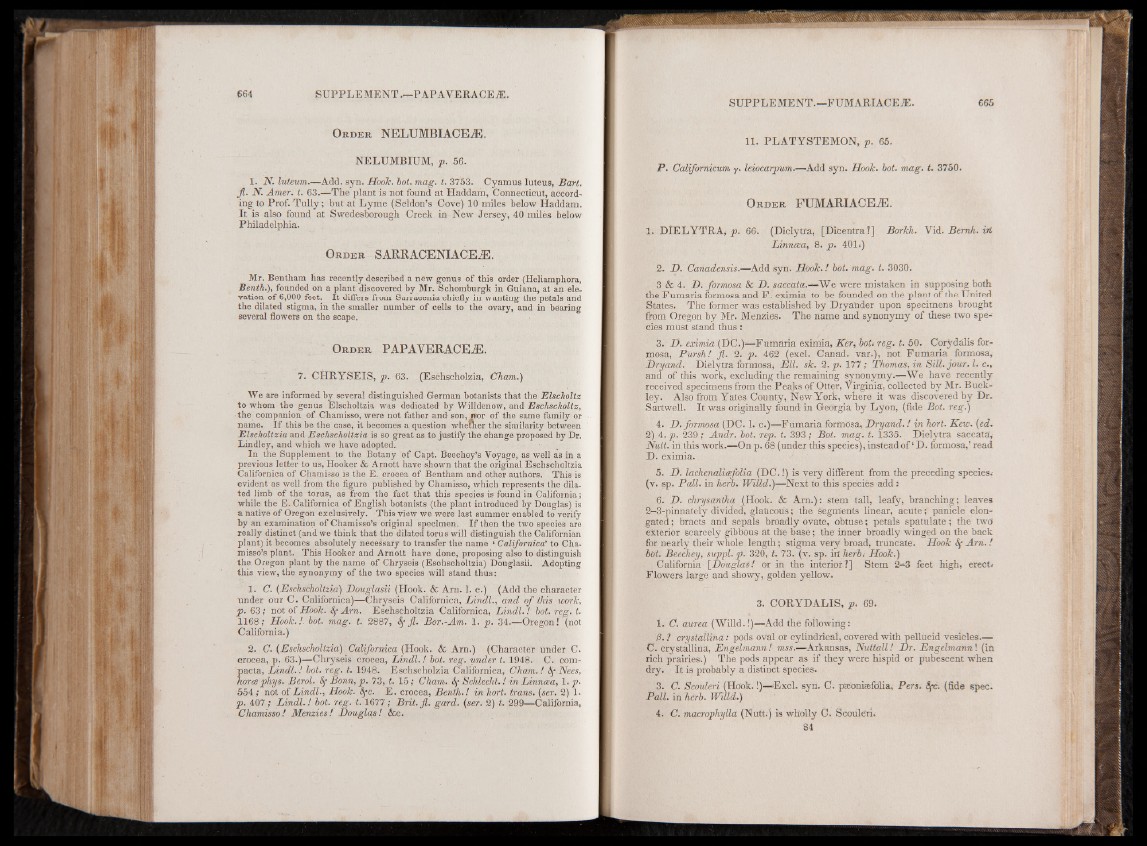
Or d e r NELUMBIACEiE.
NELUMBIUM, p. 56.
I. N. luteum.—Add. syn. Hook. hot. mag. t. 3753. Cyamus luteus, Bart.
Jl. N. Amer. t. 63.—The plant is not found at Haddam, Connecticut, according
to Prof. Tully; but at Lyme (Seldon’s Cove) 10 miles below Haddam.
It is also found at Swedesborough Creek in New Jersey, 40 miles below
Philadelphia.
Or d e r SARRACENIAGEiE.
Mr. Bentham has recently described a new genus of this order (Heliamphora,
Benth.), founded on a plant discovered by Mr. Schomburgk in Guiana, at an elevation
of 6,000 feet. It differs from Sarracenia chiefly in wanting the petals and
the dilated stigma, in the smaller number of cells to the ovary, and in bearing
several flowers on the scape.
Or d e r PAPAYERACEjE.
7. CHRYSEIS, p. 63. (Eschscholzia, Cham.)
We are informed by several distinguished German botanists that the Elscholtz
to whom the genus Elscholtzia was dedicated by Willdenow, and Eschscholtz,
the companion of Chamisso, were not father and son, »or of the same family or
name. If this be the case, it becomes a question whether the similarity between
Elscholtzia and Eschseholtzia is so great as to justify the change proposed by Dr.
Lindley, and which we have adopted.
In the Supplement to the Botany of Capt. Beechey’s Voyage, as well as in a
previous letter to us, Hooker & Arnott have shown that the original Eschseholtzia
Californica of Chamisso is the E. crocea of Bentham and other authors. This is
evident as well from the figure published by Chamisso, which represents the dilated
limb of the torus, as from the fact that this species is found in California;
while the E. Californica of English botanists (the plant introduced by Douglas) is
a native of Oregon exclusively. This view we were last summer enabled to verify
by an examination of Chamisso’s original specimen. If then the two species are
really distinct (and we think that the dilated torus will distinguish the Californian
plant) it becomes absolutely necessary to transfer the name ‘ Californica’ to Chamisso’s
plant. This Hooker and Arnott have done, proposing also to distinguish
the Oregon plant by the name of Chryseis (Eschseholtzia) Douglasii. Adopting
this view, the synonymy of the two species will stand thus:
1. C. (Eschseholtzia) Douglasii (Hook. Sc Arn. 1. c.) (Add the character
under our C. Californica)—Chryseis Californica, Lindl., and of this work,
p. 63; not of Hook. 8f Arn. Eschseholtzia Californica, Lindl.! hot. reg. t.
1168; Hook,l hot. mag. t. 2887, Sf Jl. Bor.-Am. 1. p. 34.—Oregon! (not
California.)
2. C. (Eschseholtzia) Californica (Hook. Sc Arn.) (Character under C.
crocea, p. 63.)—Chryseis crocea, Lindl.! hot. reg. under t. 1948. C. com-
pacta, Lindl.! hot. reg. t. 1948. Eschscholzia Californica, Cham.! Sf Nees,
horce phys. Berol. Sf Bonn, p. 73, t. 15; Cham. Sf Schlecht.! in Linncea, 1. p.
554 ; not of Lindl., Hook. Sfc, E. crocea, Benth.! in hort. trans. (ser. 2) 1.
p. 407; Lindl.! hot. reg. 1 .1677; Brit. Jl. gard. (ser. 2) t. 299—California,
Chamisso! Menzies! Douglas! &c.
11. PLATYSTEMON, p. 65.
P . Californicum y. leiocarpum.—Add syn. Hook. hot. mag. t. 3750.
Or d e r FUMARIACEiE.
1. D IE LY TR A , p. 66. (Diclytra, [Dicentra?] Borkh. Vid. Bernh. irt
Imnrna, 8. p. 401*)
2. D. Canadensis.—Add syn. Hook.! hot. mag. t. 3030.
3 & 4. D. formosa Sc D . saccata.—We were mistaken in supposing both
the Fumaria formosa and F . eximia to be founded on the plant of the United
States. The former was established by Drya'nder upon specimens brought
from Oregon by Mr. Menzies. The name and synonymy of these two species
must stand thus:
3. D. eximia (DC.)—Fumdria eximia, Ker, hoU reg. t. 50. Corydalis formosa,
Pursh! jl. 2. p. 462 (excl. Canad. var.), not Fumaria formosa,
Dryaiul. Dielytra formosa; Ell. sk. 2. p. 177; Thomas, in Sill. jour. 1. c.,
and of this work, excluding the remaining synonymy.—We have recently
received specimens from the Peaks of Otter, Virginia', collected by Mr. Buck-
ley. Also from Yates County, New York, where it was discovered by Dr.
Sartwell. It was originally found in Georgia by Lyon', (fide Bot. reg.)
4. D. formosa (DC. 1. c.)—Fumaria formdsa, Dryand.! in hort. Kew. (ed.
2) 4. p. 239 ; Andr. hot. rep. t. 393 ; Bot. mag. t. 1335. Dielytra saccata,
Nutt, in this work.—On p. 68 (under this species), instead of ‘ D. formosa,’ read
D. eximia.
5. D. lachenalieefolia (D C .!) is very different from the preceding species*
(v. sp. Pall, in herh. Willd.)—Next to this species add :
6. D. chrysantha (Hook. & Am.): stem tall, leafy, branching; leaves
2-3-pinnately divided, glaucous; the segments linear, acute; panicle elongated
; bracts and sepals broadly ovate, obtuse; petals spatulate ; the two'
exterior scarcely gibbous at the base; the' inner broadly winged on the back
for nearly their whole length; stigma very broad, truncate. Hook Sf A m .!
hot. Beechey, suppl. p. 320, t. 73. (v. sp. in herh* Hook.)
California [Douglas! or in the interior?] Stem 2-3 feet high, erect*
Flowers large and showy, golden yellow*
3. CORYDALIS, p. 69.
1. C. aurea (Willd.!)—Add the following:
ß. ? crystallina: pods oval or cylindrical, covered with pellucid vesicles.—
C. Crystallina, Engelmann! mss.—Arkansas, Nuttall! D r . Engelmann ! (in
rich prairies.) The pods appear as if they were hispid or pubescent when
dry. It is probably a distinct species.
3. C. Scouleri (Hook.!)—Excl. syn. C. pteonisefdlia, Pers. 8fc. (fide spec.
P a ll, in herb. Willd.)
4. C. macrophylla (Nutt*) is wholly C. Scouleri.
84